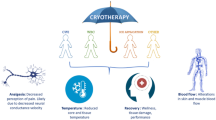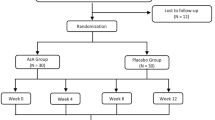Abstract
Purpose
This study aimed to explore the diagnostic ability of the cold provocation test with hands immersion in water at 10°C for 5 min in diagnosing vibration-induced white finger (VWF).
Methods
Finger skin temperature (FST) was measured in 20 VWF patients and 20 matched healthy controls, at palmar side of the distal phalanges of fingers from both hands before, during, and after hands immersion in water at 10°C (for 5 min with waterproof coverings put on both hands). Data from 4 fingers (except thumb) were evaluated at five time points: just before immersion, last minute during immersion, and at 5th, 10th, and 15th min during the post-immersion or recovery period.
Results
A positive group difference between patients and controls was revealed during the recovery period. During recovery at 95 and 70% specificity, the sensitivity ranged from 20 to 30% and 50 to 70% for evaluation with average FST for 4 fingers and 15–35% and 60–65% for evaluation with minimum FST among 4 fingers, respectively. Overall, evaluation of absolute FST at 15th min of recovery offered better diagnostic ability.
Conclusions
The cold provocation test with hands immersion in water at 10°C for 5 min could discriminate VWF patients from healthy controls; however, this test has a limited diagnostic value in diagnosing patients with VWF.

Similar content being viewed by others
References
Cherniack M, Brammer A, Meyer J, Morse T, Peterson D, Fu R (2003) Skin temperature recovery from cold provocation in workers exposed to vibration: a longitudinal study. Occup Environ Med 60:962–968
Gautherie M (1995) Clinical studies of the vibration syndrome using a cold stress test measuring finger temperature. Cent Eur J Public Health 3 suppl:5–10
Greenberg RS, Daniels SR, Flanders WD, Eley JW, Boring JR (2005) Diagnostic testing. In: Medical epidemiology, 4th edn. Lange Medical Books/McGraw-Hill, New York, pp 94–95
Harada N (1987) Esthesiometry, nail compression test and other function tests used in Japan for evaluating the hand-arm vibration syndrome. Scand J Work Environ Health 13:330–333
Harada N, Mahbub MH (2008) Diagnosis of vascular injuries in hand-arm vibration syndrome. Int Arch Occup Environ Health 81:507–518
Harada N, Yoshimura M, Laskar MS (1999) A minireview of studies conducted in Japan using finger-skin temperature during cold-stress tests for the diagnosis of hand-arm vibration syndrome. Int Arch Occup Environ Health 72:330–334
International Organization for Standardization (2005a) Mechanical vibration and shock—Cold provocation tests for the assessment of peripheral vascular function—Part 1: Measurement and evaluation of finger skin temperature. International Standard 14835—Part 1
International Organization for Standardization (2005b) Mechanical vibration and shock—Cold provocation tests for the assessment of peripheral vascular function—Part 2: Measurement and evaluation of finger systolic blood pressure. International Standard 14835—Part 2
Juul C, Nielsen SL (1981) Locally induced digital vasospasm detected by delayed rewarming in Raynaud’s phenomenon of occupational origin. Br J Ind Med 38:87–90
Kurumatani N (1984) Evaluation of cold water immersion test as a means of mass examination for workers using vibrating tools—with special reference to fingertip skin temperature obtained by 10°C for 10 min method. J Nara Med Assoc 35:403–418 in Japanese, with English abstract
Lindsell CJ, Griffin MJ (2000) A standardized test battery for assessing vascular and neurological components of the hand-arm vibration syndrome. In: Lundstrom R, Lindmark A (eds) Proceeedings of the 8th International Conference on Hand-Arm Vibration. Arbetslivsinstitutet, Stockholm, pp 133–141
Lindsell CJ, Griffin MJ (2001) Interpretation of the finger skin temperature response to cold provocation. Int Arch Occup Environ Health 74:325–335
Mason HJ, Poole K, Saxton J (2003) A critique of a UK standardized test of finger rewarming after cold provocation in the diagnosis and staging of hand-arm vibration. Occup Med 53:325–330
Poole K, Elms J, Mason HJ (2004) The diagnostic value of finger systolic blood pressure and cold-provocation testing for the vascular component of hand-arm vibration syndrome in health surveillance. Occup Med 54:520–527
Poole K, Elms J, Mason H (2006) Modification of Stockholm vascular scale. Occup Med 56:422–425
Proud G, Burke F, Lawson IJ, McGeoch KL, Miles JN (2003) Cold provocation testing and hand-arm vibration syndrome–an audit of the results of the department of trade and industry scheme for the evaluation of miners. Br J Surg 90:1076–1079
Salem KM, Baker M, Hilliam RM, Davies S, Deighton C, Bainbridge LC, Manning G (2009) Analysis of rewarming curves in Raynaud’s phenomenon of various aetiologies. J Hand Surg Eur Vol 34:621–626
Virokannas H, Rintamaki H (1991) Finger blood pressure and rewarming rate for screening and diagnosis of Raynaud’s phenomenon in workers exposed to vibration. Br J Ind Med 48:480–484
Virokannas H, Miesmaa O, Bergstrom T (1990) Evaluation of vibration white finger using finger systolic blood pressure and rewarming rate of finger skin. In: Okada A, Taylor W, Dupuis H (eds) Hand-arm vibration. Kanazawa: Kyoei Press, pp 89–92
Voelter-Mahlknecht S, Krummenauer F, Koulele D, Mahlknecht U, Escobar Pinzon LC, Dupuis H, Letzel S (2006) First experiences with DIN ISO 14835–1 in the context of vibration-induced white finger disease. Int Arch Occup Environ Health 79:427–432
Acknowledgments
As a contract research project, this work was funded by the Japanese Ministry of Health, Labour and Welfare.
Conflict of interest
The authors declare that they have no conflict of interest.
Author information
Authors and Affiliations
Corresponding author
Rights and permissions
About this article
Cite this article
Mahbub, M.H., Ishitake, T., Kurozawa, Y. et al. Diagnostic performance of cold provocation test with hands immersion in water at 10°C for 5 min evaluated in vibration-induced white finger patients and matched controls. Int Arch Occup Environ Health 84, 805–811 (2011). https://doi.org/10.1007/s00420-011-0612-0
Received:
Accepted:
Published:
Issue Date:
DOI: https://doi.org/10.1007/s00420-011-0612-0




